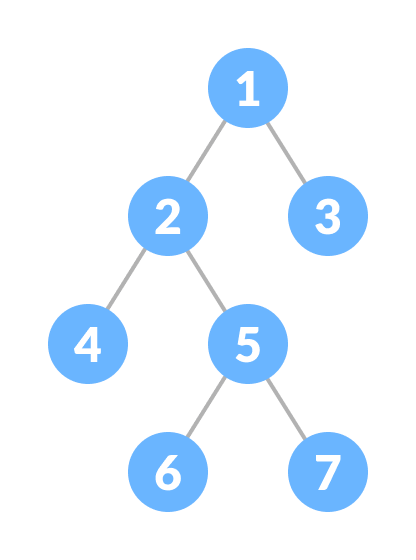Table of Contents
In this tutorial, you will learn about full binary tree and its different theorems. Also, you will find working examples to check full binary tree in C, C++, Java and Python.
A full Binary tree is a special type of binary tree in which every parent node/internal node has either two or no children.
It is also known as a proper binary tree.

1. Full Binary Tree Theorems
Let, i = the number of internal nodes
n = be the total number of nodes
l = number of leaves
λ = number of levels
- The number of leaves is
i + 1. - The total number of nodes is
2i + 1. - The number of internal nodes is (n – 1) / 2.
- The number of leaves is
(n + 1) / 2. - The total number of nodes is
2l – 1. - The number of internal nodes is
l – 1. - The number of leaves is at most
2λ - 1.
2. Python, Java and C/C++ Examples
The following code is for checking if a tree is a full binary tree.
Source code by Python Language:
# Checking if a binary tree is a full binary tree in Python
# Creating a node
class Node:
def __init__(self, item):
self.item = item
self.leftChild = None
self.rightChild = None
# Checking full binary tree
def isFullTree(root):
# Tree empty case
if root is None:
return True
# Checking whether child is present
if root.leftChild is None and root.rightChild is None:
return True
if root.leftChild is not None and root.rightChild is not None:
return (isFullTree(root.leftChild) and isFullTree(root.rightChild))
return False
root = Node(1)
root.rightChild = Node(3)
root.leftChild = Node(2)
root.leftChild.leftChild = Node(4)
root.leftChild.rightChild = Node(5)
root.leftChild.rightChild.leftChild = Node(6)
root.leftChild.rightChild.rightChild = Node(7)
if isFullTree(root):
print("The tree is a full binary tree")
else:
print("The tree is not a full binary tree")
Source code by Java Language:
// Checking if a binary tree is a full binary tree in Java
class Node {
int data;
Node leftChild, rightChild;
Node(int item) {
data = item;
leftChild = rightChild = null;
}
}
class BinaryTree {
Node root;
// Check for Full Binary Tree
boolean isFullBinaryTree(Node node) {
// Checking tree emptiness
if (node == null)
return true;
// Checking the children
if (node.leftChild == null && node.rightChild == null)
return true;
if ((node.leftChild != null) && (node.rightChild != null))
return (isFullBinaryTree(node.leftChild) && isFullBinaryTree(node.rightChild));
return false;
}
public static void main(String args[]) {
BinaryTree tree = new BinaryTree();
tree.root = new Node(1);
tree.root.leftChild = new Node(2);
tree.root.rightChild = new Node(3);
tree.root.leftChild.leftChild = new Node(4);
tree.root.leftChild.rightChild = new Node(5);
tree.root.rightChild.leftChild = new Node(6);
tree.root.rightChild.rightChild = new Node(7);
if (tree.isFullBinaryTree(tree.root))
System.out.print("The tree is a full binary tree");
else
System.out.print("The tree is not a full binary tree");
}
}
Source code by C Language:
// Checking if a binary tree is a full binary tree in C
#include <stdbool.h>
#include <stdio.h>
#include <stdlib.h>
struct Node {
int item;
struct Node *left, *right;
};
// Creation of new Node
struct Node *createNewNode(char k) {
struct Node *node = (struct Node *)malloc(sizeof(struct Node));
node->item = k;
node->right = node->left = NULL;
return node;
}
bool isFullBinaryTree(struct Node *root) {
// Checking tree emptiness
if (root == NULL)
return true;
// Checking the presence of children
if (root->left == NULL && root->right == NULL)
return true;
if ((root->left) && (root->right))
return (isFullBinaryTree(root->left) && isFullBinaryTree(root->right));
return false;
}
int main() {
struct Node *root = NULL;
root = createNewNode(1);
root->left = createNewNode(2);
root->right = createNewNode(3);
root->left->left = createNewNode(4);
root->left->right = createNewNode(5);
root->left->right->left = createNewNode(6);
root->left->right->right = createNewNode(7);
if (isFullBinaryTree(root))
printf("The tree is a full binary tree\n");
else
printf("The tree is not a full binary tree\n");
}
Source code by C++ Language:
// Checking if a binary tree is a full binary tree in C++
#include <iostream>
using namespace std;
struct Node {
int key;
struct Node *left, *right;
};
// New node creation
struct Node *newNode(char k) {
struct Node *node = (struct Node *)malloc(sizeof(struct Node));
node->key = k;
node->right = node->left = NULL;
return node;
}
bool isFullBinaryTree(struct Node *root) {
// Checking for emptiness
if (root == NULL)
return true;
// Checking for the presence of children
if (root->left == NULL && root->right == NULL)
return true;
if ((root->left) && (root->right))
return (isFullBinaryTree(root->left) && isFullBinaryTree(root->right));
return false;
}
int main() {
struct Node *root = NULL;
root = newNode(1);
root->left = newNode(2);
root->right = newNode(3);
root->left->left = newNode(4);
root->left->right = newNode(5);
root->left->right->left = newNode(6);
root->left->right->right = newNode(7);
if (isFullBinaryTree(root))
cout << "The tree is a full binary tree\n";
else
cout << "The tree is not a full binary tree\n";
}
Related posts:
Counting Sort Algorithm
Complete Binary Tree
Heap Sort Algorithm
Breadth first search
Shell Sort Algorithm
Selection Sort Algorithm
Queue Data Structure
Dynamic Programming
Balanced Binary Tree
Insertion on a B+ Tree
Merge Sort Algorithm
B+ Tree
Strongly Connected Components
Insertion into a B-tree
Linear Search
Kruskal's Algorithm
Insertion Sort Algorithm
Linked List Operations: Traverse, Insert and Delete
Deletion from a B+ Tree
Graph Data Stucture
Sorting Algorithm
Longest Common Subsequence
Linked list Data Structure
Floyd-Warshall Algorithm
Greedy Algorithm
Priority Queue
Insertion in a Red-Black Tree
Types of Queues
Decrease Key and Delete Node Operations on a Fibonacci Heap
Backtracking Algorithm
Why Learn Data Structures and Algorithms?
Rabin-Karp Algorithm

